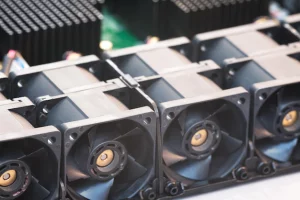Hot and cold aisles are crucial for optimising the performance of your data centre while effectively managing energy consumption. By strategically implementing our EziBlank blanking panels, you can significantly enhance air-flow management, ensuring that your cooling systems operate at peak efficiency. Our innovative solutions not only maximise your infrastructure investment but also contribute to lowering operational costs. Discover how EziBlank can transform your data centre into a model of efficiency, sustainability, and performance today!
How airflow works inside of a server
Airflow inside a server is meticulously designed to ensure that the hardware operates within safe temperature ranges, which is critical for maintaining performance and preventing overheating. Cool air is typically drawn in from the front of the server through intake fans, passes over the heat-generating components such as the CPU, memory, and hard drives, and is then expelled as hot air through exhaust fans at the back of the server. This controlled airflow ensures that each component receives the cooling it needs. Effective airflow management within the server, complemented by data centre solutions like blanking panels, helps maintain optimal operating conditions, extends the lifespan of the equipment, and reduces the overall energy required for cooling.
Read More
How to create the perfect data center airflow management plan
Creating the perfect data centre airflow management plan is essential for optimising cooling efficiency, reducing energy consumption, and ensuring the longevity of your equipment. The process begins with a thorough assessment of the current airflow dynamics, identifying any hot spots or areas where air circulation is suboptimal. Key components of an effective plan include the strategic placement of blanking panels to prevent hot air recirculation, proper cable management to avoid airflow blockages, and the use of perforated floor tiles to direct cool air precisely where it’s needed. Additionally, implementing cold or hot aisle containment can further enhance airflow efficiency by separating hot and cold air streams. Regular monitoring and adjustments are crucial to maintaining optimal conditions as the data centre evolves. By focusing on these elements, you can create an airflow management plan that maximises performance and minimises costs.
Read More
Hot Aisle vs Cold Aisle Containment
Hot aisle and cold aisle containment are two critical strategies used in data centres to enhance cooling efficiency and reduce energy consumption. In a cold aisle containment setup, cold air is contained within the aisle where the fronts of the server racks face each other, ensuring that only cool air is delivered directly to the equipment. This prevents the mixing of cold air with hot exhaust air, improving cooling efficiency. Conversely, hot aisle containment involves enclosing the aisle where the backs of the servers expel hot air. This containment captures and directs the hot air back to the cooling systems, preventing it from mixing with the cool air in the room. Both methods are effective, but the choice between hot and cold aisle containment depends on the specific design and cooling needs of the data centre. Implementing either strategy can lead to significant improvements in energy efficiency and overall system performance.
Read More
What is Hot Aisle Containment
Hot aisle containment is a cooling strategy used in data centres to improve energy efficiency by isolating the hot air generated by servers. In this setup, the hot aisle, where the backs of the servers expel warm air, is enclosed, preventing the hot air from mixing with the cool air in the rest of the data centre. This containment ensures that the hot air is directed straight to the cooling units, where it is removed or recycled, thereby reducing the workload on the cooling system. By maintaining a clear separation between hot and cold airflows, hot aisle containment helps to lower energy consumption, enhance cooling efficiency, and maintain optimal operating conditions for the servers, making it a crucial strategy for modern data centre management.
Read More
